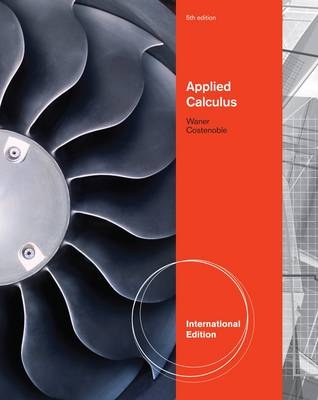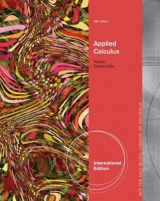
Applied Calculus, International Edition
Brooks/Cole (Verlag)
9781439049921 (ISBN)
- Titel erscheint in neuer Auflage
- Artikel merken
Full of relevant and current real-world applications; Stefan Waner and Steven Costenoble’s APPLIED CALCULUS; 5e; International Edition helps your students relate to mathematics! Throughout the text is clearly delineated; thorough Microsoft® Excel® and Graphing Calculator instruction; optional so instructors can include any amount of technology instruction in their courses. Acclaimed for accuracy and readability; APPLIED CALCULUS; 5e; International Edition connects with all types of teaching and learning styles. Resources like the accompanying website allow the text to support a range of course formats; from traditional lectures to strictly online courses.
Stefan Waner and Steven R. Costenoble both received their Ph.D. from the University of Chicago, having studied several years apart with the same advisor, J. Peter May. Their paths merged when Steven joined Stefan at Hofstra University in 1987; since then they have coauthored 18 research papers as well as a research-level monograph in algebraic topology. By the early 1990s they had become dissatisfied with many of the Finite Mathematics and Applied Calculus textbooks. They wanted textbooks that were more readable and relevant to students' interests, containing examples and exercises that were interesting, and reflected the interactive approaches and techniques they found worked well with their own students. It therefore seemed natural to extend their research collaboration to a joint textbook writing project that expressed these ideals. To this day, they continue to work together on their textbook projects, their research in algebraic topology, and their teaching. Stefan Waner and Steven R. Costenoble both received their Ph.D. from the University of Chicago, having studied several years apart with the same advisor, J. Peter May. Their paths merged when Steven joined Stefan at Hofstra University in 1987; since then they have coauthored 18 research papers as well as a research-level monograph in algebraic topology. By the early 1990s they had become dissatisfied with many of the Finite Mathematics and Applied Calculus textbooks. They wanted textbooks that were more readable and relevant to students' interests, containing examples and exercises that were interesting, and reflected the interactive approaches and techniques they found worked well with their own students. It therefore seemed natural to extend their research collaboration to a joint textbook writing project that expressed these ideals. To this day, they continue to work together on their textbook projects, their research in algebraic topology, and their teaching.
0. PRECALCULUS REVIEW.
Real Numbers. Exponents and Radicals. Multiplying and Factoring Algebraic Equations. Rational Expressions. Solving Polynomial Equations. Solving Miscellaneous Equations. The Coordinate Plane.
1. FUNCTIONS AND LINEAR MODELS.
Functions from the Numerical; Algebraic; and Graphical Viewpoints. Applications: Functions and Models. Linear Functions and Models. Linear Regression. Key Concepts. Review Exercises. Case Study: Modeling Spending on Internet Advertising. Technology Guides. Optional Internet Topic: New Functions from Old: Scaled and Shifted Functions.
2. NONLINEAR FUNCTIONS AND MODELS.
Quadratic Functions and Models. Exponential Functions and Models. Logarithmic Functions and Models. Logistic Functions and Models. Key Concepts. Review Exercises. Case Study: Checking up on Malthus. Technology Guides. Optional Internet Topics: Inverse Functions. Using and Deriving Algebraic Properties of Logarithms.
3. INTRODUCTION TO THE DERIVATIVE.
Limits: Numerical and Graphical Approaches. Limits and Continuity. Limits: Algebraic Approach. Average Rate of Change. Derivatives: Numerical and Graphical Viewpoints. Derivatives: Algebraic Viewpoint. Key Concepts. Review Exercises. Case Study: Reducing Sulfur Emissions. Technology Guides. Optional Internet Topics: Sketching the Graph of the Derivative. Proof of the Power Rule. Continuity and Differentiability.
4. TECHNIQUES OF DIFFERENTIATION WITH APPLICATIONS.
Derivatives of Powers; Sums; and Constant Multiples. A First Application: Marginalnalysis. The Product and Quotient Rules. The Chain Rule. Derivatives of Logarithmic and Exponential Functions. Implicit Differentiation. Key Concepts. Review Exercises. Case Study: Projecting Market Growth. Technology Guides. Optional Internet Topic: Linear Approximation and Error Estimation.
5. FURTHER APPLICATIONS OF THE DERIVATIVE.
Maxima and Minima. Applications of Maxima and Minima. Higher Order Derivatives: Acceleration and Concavity. Analyzing Graphs. Related Rates. Elasticity. Key Concepts. Review Exercises. Case Study: Production Lot Size Management. Technology Guides.
6. THE INTEGRAL.
The Indefinite Integral. Substitution. The Definite Integral: Numerical and Graphical Approaches. The Definite Integral: Algebraic Approach and the Fundamental Theorem of Calculus. Key Concepts. Review Exercises. Case Study: Wage Inflation. Technology Guides. Optional Internet Topic: Numerical Integration.
7. FURTHER INTEGRATION TECHNIQUES AND APPLICATIONS OF THE INTEGRAL.
Integration by Parts. Area Between Two Curves and Applications. Averages and Moving Averages. Applications to Business and Economics: Consumers’’ and Producers’’ Surplus and Continuous Income Streams. Improper Integrals and Applications. Differential Equations and Applications. Key Concepts. Review Exercises. Case Study: Estimating Tax Revenues. Technology Guides. Optional Internet Topic: Taylor Polynomials.
8. FUNCTIONS OF SEVERAL VARIABLES.
Functions of Several Variables from the Numerical; Algebraic; and Graphical Viewpoints. Partial Derivatives. Maxima and Minima. Constrained Maxima and Minima and Applications. Double Integrals and Applications. Key Concepts. Review Exercises. Case Study: Modeling Household Income. Technology Guides. Optional Internet Topic: The Chain Rule for Functions of Several Variables.
9. TRIGONOMETRIC MODELS.
Trigonometric Functions; Models; and Regression. Derivatives of Trigonometric Functions and Applications. Integrals of Trigonometric Functions and Applications. Key Concepts. Review Exercises. Case Study: Predicting Cocoa Inventories. Technology Guides.
ANSWERS TO SELECTED EXERCISES.
INDEX.
OPTIONAL INTERNET TOPIC.
S. CALCULUS APPLIED TO PROBABILITY AND STATISTICS.
Introduction.
Continuous Random Variables and Histograms.
Probability Density Functions: Uniform; Exponential; Normal; and Beta.
Mean; Median; Variance and Standard Deviation.
Case Study: Creating a Family Trust.
| Erscheint lt. Verlag | 31.1.2010 |
|---|---|
| Verlagsort | CA |
| Sprache | englisch |
| Maße | 200 x 248 mm |
| Gewicht | 1200 g |
| Themenwelt | Mathematik / Informatik ► Mathematik ► Analysis |
| Mathematik / Informatik ► Mathematik ► Angewandte Mathematik | |
| ISBN-13 | 9781439049921 / 9781439049921 |
| Zustand | Neuware |
| Informationen gemäß Produktsicherheitsverordnung (GPSR) | |
| Haben Sie eine Frage zum Produkt? |
aus dem Bereich



